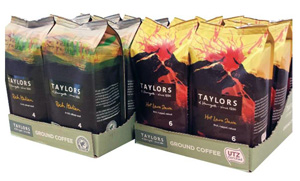Corrugated Packaging Taylor-Made for Coffee Supplier

The Confederation of Paper Industries (CPI), Brussels, Belgium, has hailed the collaboration of two corrugated companies involved in producing new packaging for a leading U.K. roasted ground coffee supplier as an excellent example of the flexibility and innovation that the sector offers retailers and brand owners. The two board converters teamed up to develop new-style corrugated Shelf-Ready Packaging (SRP) as part of a rebranding exercise by Taylors of Harrogate for its lifestyle range of coffees. The new-style SRP not only enhances visibility on-shelf but also makes the products easier to identify and handle back of store.
Taylors’ packaging buyer, Matt Hunt, believes that because each variant of corrugated SRP carries two or three additional colors for the text and graphics, the products’ easily identifiable outer packaging is having a direct in-store benefit long before it comes under consumer scrutiny.
According to Hunt, "research shows that if shelf-stackers can’t readily identify a particular product back of store, then they’re likely not to bother to go looking for it because of pressure on time. The result is slow or non-existent replenishment."
Key to the project’s successful outcome was the use of virtually identical production equipment and the same consumables by the separate corrugated suppliers contracted in accordance with Taylors’ requirements.
CPI’s Director of Packaging Affairs, Andy Barnetson, noted that "there are many benefits that have been brought to bear in support of Taylors’ sales and marketing strategy through the development and implementation of this corrugated SRP application. "To name but three—the introduction of strong messaging in support of the brand on-shelf, the simple yet hugely effective use of solid flood color coats to facilitate restocking in-store, and, given the appropriate level of expertise, the capability of testliner to match kraft in terms of print reproduction.
"Less obvious but hugely positive across the entire corrugated packaging supply chain has been the very constructive approach towards partnering - not just between brand owner and manufacturer but between these two board converters themselves," Barnetson continued. "They’ve worked closely to address the potential constraints imposed by differing sources of material and, in doing so, have delivered the optimum solution for a shared client. It’s surely a classic case of the corrugated sector being every bit as flexible in not just delivering customized solutions that are fit for purpose, but also in how they’re accomplished."
TAPPI
http://www.tappi.org/
 The Confederation of Paper Industries (CPI), Brussels, Belgium, has hailed the collaboration of two corrugated companies involved in producing new packaging for a leading U.K. roasted ground coffee supplier as an excellent example of the flexibility and innovation that the sector offers retailers and brand owners. The two board converters teamed up to develop new-style corrugated Shelf-Ready Packaging (SRP) as part of a rebranding exercise by Taylors of Harrogate for its lifestyle range of coffees. The new-style SRP not only enhances visibility on-shelf but also makes the products easier to identify and handle back of store.
The Confederation of Paper Industries (CPI), Brussels, Belgium, has hailed the collaboration of two corrugated companies involved in producing new packaging for a leading U.K. roasted ground coffee supplier as an excellent example of the flexibility and innovation that the sector offers retailers and brand owners. The two board converters teamed up to develop new-style corrugated Shelf-Ready Packaging (SRP) as part of a rebranding exercise by Taylors of Harrogate for its lifestyle range of coffees. The new-style SRP not only enhances visibility on-shelf but also makes the products easier to identify and handle back of store.